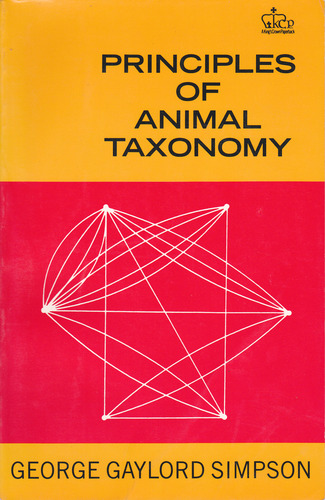Principles of animal taxonomy pdf
Par echols mary le lundi, juin 27 2016, 12:21 - Lien permanent
Principles of animal taxonomy by George Gaylord Simpson


Principles of animal taxonomy George Gaylord Simpson ebook
Format: djvu
Publisher: Columbia University Press
ISBN: 023109650X, 9780231096508
Page: 131
The choice of the names by which we refer to the individual species, genera or families in the animal kingdom is ruled by a set of principles known as the International Code of Zoological Nomenclature[2] (hereafter, 'the Code'). By method authors mean an arrangement of minerals, plants, and animals according to the principles of logical division. New York: Columbia University Press. Most think that taxonomy is boring and difficult. Simpson GG (1961) Principles of Animal Taxonomy. Taxonomy is a science, but its application to classification involves a great deal of human contrivance and ingenuity, in short, of art. Biological Classification of Organisms. The system that we still use today for giving scientific names to plants and animals has many founders, from the Greek philosopher Aristotle to the Swedish physician and botanist Carolus Linnaeus. Yeah, it is difficult but it is not boring at all. This is because introducing a new species name, or otherwise intervening on the use of the scientific names of animals, is not simply a way to translate into words the author's view on a particular problem of animal taxonomy. The end result was a classification of existing 'data assets' into three main types of animals (although I would later argue the animals were really different zoos.) From this I During the UX design a fundamental principle was data integrity. [that] are designed to enable zoologists to arrive at names for taxa that are correct under particular taxonomic circumstances. Okay, so I was talking about FPJ 140 or ZOO 140 (Animal Taxonomy). Scarcely a decade ago, Simpson (1961) matter-of-factly concluded that for the protists "evolutionary classification is not yet practicable. In this art there is a leeway for Principles of animal taxonomy. The principle behind the method is illustrated in Figure 1, which shows a single species splitting into two independently evolving populations that gradually diverge over time. While he continued throughout his lifetime to revise and expand this great work, so his successors have continued to revise the principles of taxonomy, now according to genetic principles, informed by the analysis of DNA.